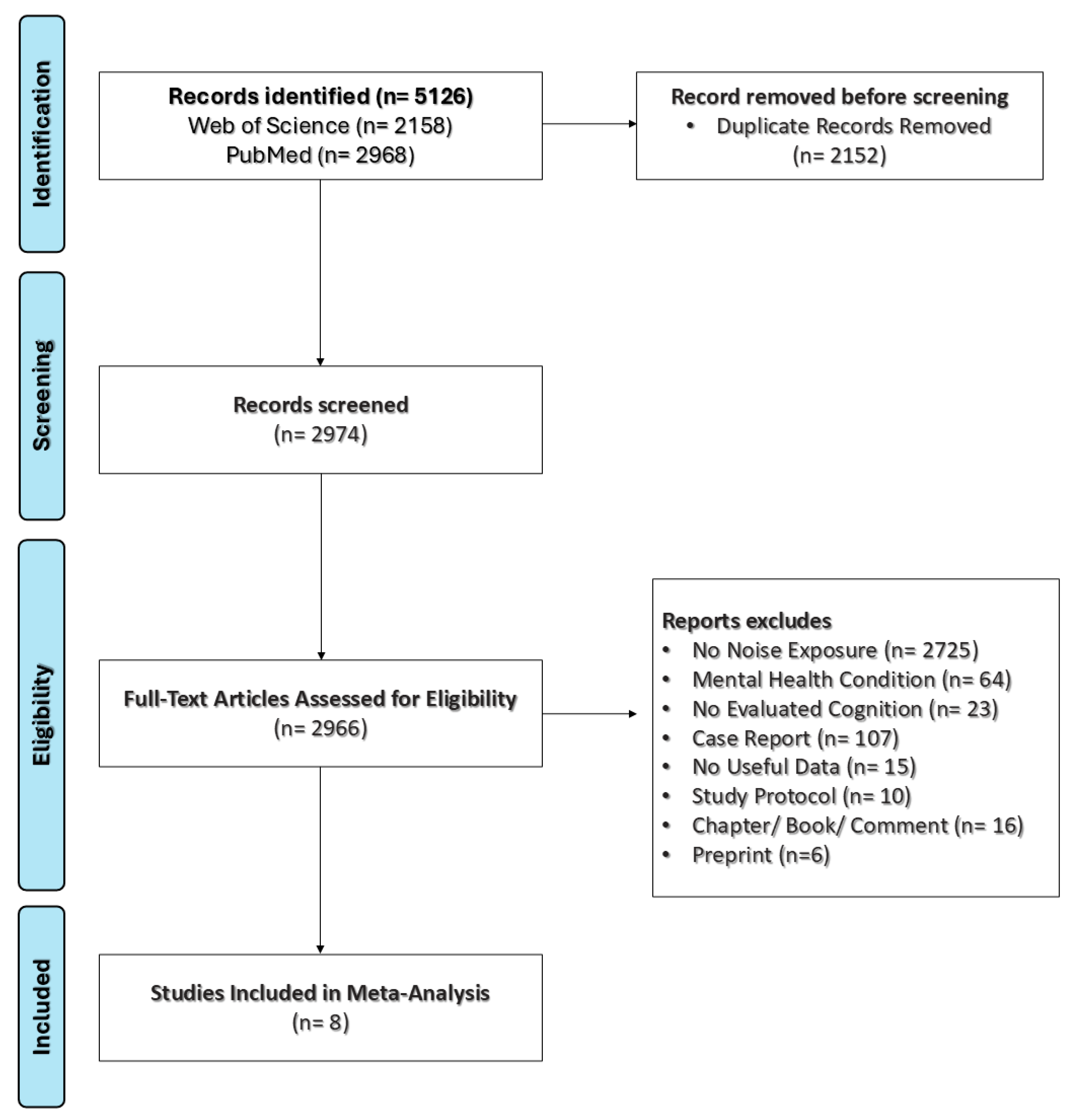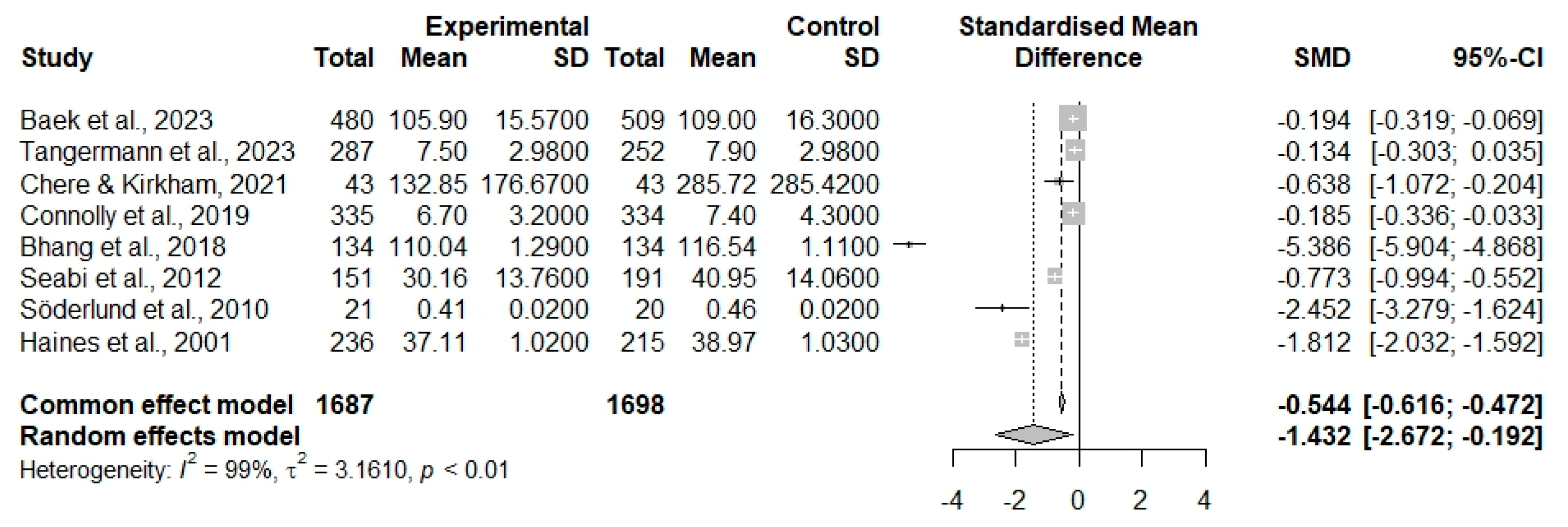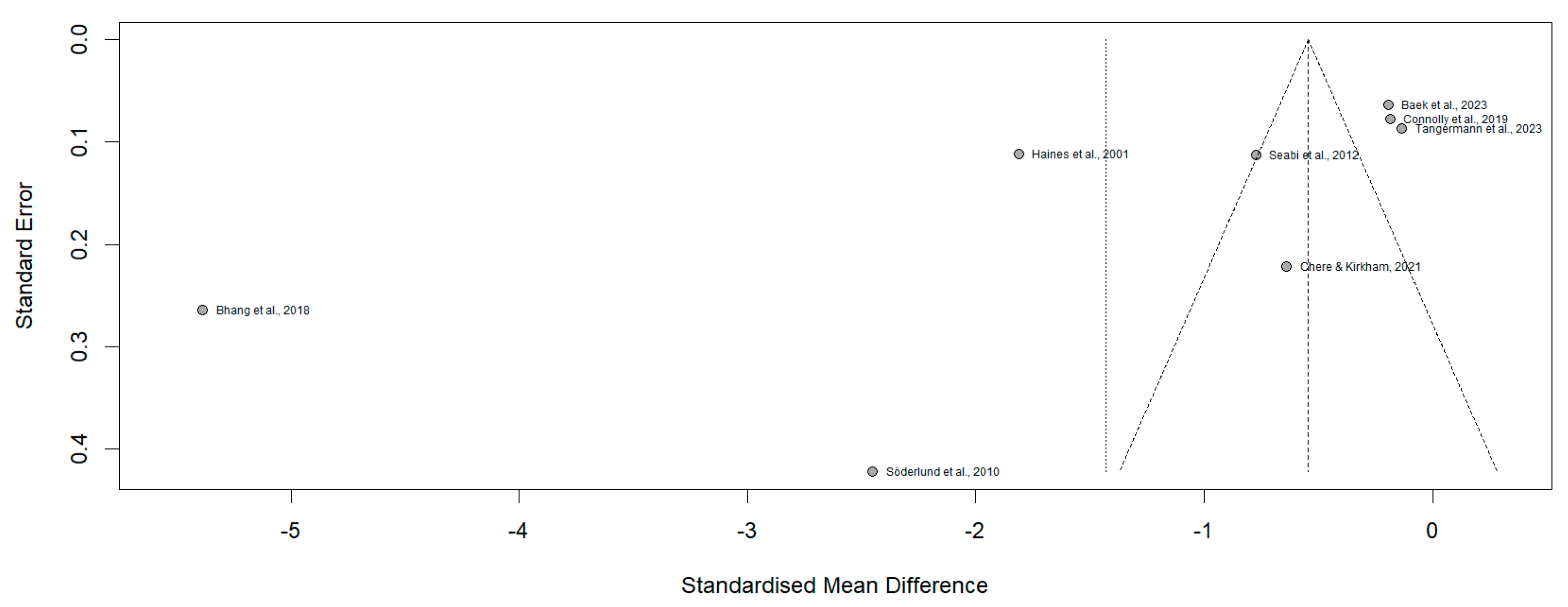The Influence of Noise Exposure on Cognitive Function in Children and Adolescents: A Meta-Analysis
Abstract
1. Introduction
2. Materials and Methods
2.1. Search Strategy
2.2. Inclusion and Exclusion Criteria
2.3. Data Extraction
2.4. Quality Evaluation
2.5. Statistical Methods
3. Results
3.1. Study Characteristics
3.2. Impact of Noise Exposure on Cognition Function in Children and Adolescents
3.3. Sensitivity Analysis of Study Influence on Effect Size
3.4. Quality Analysis of Research Reports
4. Discussion
5. Conclusions
Supplementary Materials
Author Contributions
Funding
Data Availability Statement
Conflicts of Interest
References
- Spiegel, J.A.; Goodrich, J.M.; Morris, B.M.; Osborne, C.M.; Lonigan, C.J. Relations between Executive Functions and Academic Outcomes in Elementary School Children: A Meta-Analysis. Psychol. Bull. 2021, 147, 329–351. [Google Scholar] [CrossRef] [PubMed]
- Hahad, O.; Kuntic, M.; Al-Kindi, S.; Kuntic, I.; Gilan, D.; Petrowski, K.; Daiber, A.; Münzel, T. Noise and Mental Health: Evidence, Mechanisms, and Consequences. J. Expo. Sci. Environ. Epidemiol. 2024. [Google Scholar] [CrossRef] [PubMed]
- Tangermann, L.; Vienneau, D.; Saucy, A.; Hattendorf, J.; Schäffer, B.; Wunderli, J.M.; Röösli, M. The Association of Road Traffic Noise with Cognition in Adolescents: A Cohort Study in Switzerland. Environ. Res. 2023, 218, 115031. [Google Scholar] [CrossRef]
- Chere, B.; Kirkham, N. The Negative Impact of Noise on Adolescents’ Executive Function: An Online Study in the Context of Home-Learning During a Pandemic. Front. Psychol. 2021, 12, 715301. [Google Scholar] [CrossRef] [PubMed]
- Connolly, D.; Dockrell, J.; Shield, B.; Conetta, R.; Mydlarz, C.; Cox, T. The Effects of Classroom Noise on the Reading Comprehension of Adolescents. J. Acoust. Soc. Am. 2019, 145, 372. [Google Scholar] [CrossRef]
- Klatte, M.; Bergström, K.; Lachmann, T. Does Noise Affect Learning? A Short Review on Noise Effects on Cognitive Performance in Children. Front. Psychol. 2013, 4, 578. [Google Scholar] [CrossRef] [PubMed]
- Valente, D.L.; Plevinsky, H.M.; Franco, J.M.; Heinrichs-Graham, E.C.; Lewis, D.E. Experimental Investigation of the Effects of the Acoustical Conditions in a Simulated Classroom on Speech Recognition and Learning in Children. J. Acoust. Soc. Am. 2012, 131, 232–246. [Google Scholar] [CrossRef]
- Bhang, S.-Y.; Yoon, J.; Sung, J.; Yoo, C.; Sim, C.; Lee, C.; Lee, J.; Lee, J. Comparing Attention and Cognitive Function in School Children across Noise Conditions: A Quasi-Experimental Study. Psychiatry Investig. 2018, 15, 620–627. [Google Scholar] [CrossRef]
- Stansfeld, S.A.; Berglund, B.; Clark, C.; Lopez-Barrio, I.; Fischer, P.; Ohrström, E.; Haines, M.M.; Head, J.; Hygge, S.; van Kamp, I.; et al. Aircraft and Road Traffic Noise and Children’s Cognition and Health: A Cross-National Study. Lancet 2005, 365, 1942–1949. [Google Scholar] [CrossRef]
- Herring, C.A.; Simmons, R.K.; Freytag, S.; Poppe, D.; Moffet, J.J.D.; Pflueger, J.; Buckberry, S.; Vargas-Landin, D.B.; Clément, O.; Echeverría, E.G.; et al. Human Prefrontal Cortex Gene Regulatory Dynamics from Gestation to Adulthood at Single-Cell Resolution. Cell 2022, 185, 4428–4447.e28. [Google Scholar] [CrossRef]
- Page, M.J.; McKenzie, J.E.; Bossuyt, P.M.; Boutron, I.; Hoffmann, T.C.; Mulrow, C.D.; Shamseer, L.; Tetzlaff, J.M.; Akl, E.A.; Brennan, S.E.; et al. The PRISMA 2020 Statement: An Updated Guideline for Reporting Systematic Reviews. BMJ 2021, 372, n71. [Google Scholar] [CrossRef] [PubMed]
- Sterne, J.A.C.; Savović, J.; Page, M.J.; Elbers, R.G.; Blencowe, N.S.; Boutron, I.; Cates, C.J.; Cheng, H.-Y.; Corbett, M.S.; Eldridge, S.M.; et al. RoB 2: A Revised Tool for Assessing Risk of Bias in Randomised Trials. BMJ 2019, 366, I4898. [Google Scholar] [CrossRef] [PubMed]
- Shim, S.R.; Kim, S.-J. Intervention Meta-Analysis: Application and Practice Using R Software. Epidemiol. Health 2019, 41, e2019008. [Google Scholar] [CrossRef] [PubMed]
- Abbas, A.; Hefnawy, M.T.; Negida, A. Meta-Analysis Accelerator: A Comprehensive Tool for Statistical Data Conversion in Systematic Reviews with Meta-Analysis. BMC Med. Res. Methodol. 2024, 24, 243. [Google Scholar] [CrossRef]
- Wan, X.; Wang, W.; Liu, J.; Tong, T. Estimating the Sample Mean and Standard Deviation from the Sample Size, Median, Range and/or Interquartile Range. BMC Med. Res. Methodol. 2014, 14, 135. [Google Scholar] [CrossRef]
- Baek, K.; Park, C.; Sakong, J. The Impact of Aircraft Noise on the Cognitive Function of Elementary School Students in Korea. Noise Health 2023, 25, 83–91. [Google Scholar] [CrossRef]
- Seabi, J.; Cockcroft, K.; Goldschagg, P.; Greyling, M. The Impact of Aircraft Noise Exposure on South African Children’s Reading Comprehension: The Moderating Effect of Home Language. Noise Health 2012, 14, 244–252. [Google Scholar] [CrossRef]
- Söderlund, G.B.; Sikström, S.; Loftesnes, J.M.; Sonuga-Barke, E.J. The Effects of Background White Noise on Memory Performance in Inattentive School Children. Behav. Brain Funct. 2010, 6, 55. [Google Scholar] [CrossRef]
- Haines, M.M.; Stansfeld, S.A.; Brentnall, S.; Head, J.; Berry, B.; Jiggins, M.; Hygge, S. The West London Schools Study: The Effects of Chronic Aircraft Noise Exposure on Child Health. Psychol. Med. 2001, 31, 1385–1396. [Google Scholar] [CrossRef]
- Borenstein, M. How to Understand and Report Heterogeneity in a Meta-Analysis: The Difference between I-Squared and Prediction Intervals. Integr. Med. Res. 2023, 12, 101014. [Google Scholar] [CrossRef]
- Liu, L.; Shen, P.; He, T.; Chang, Y.; Shi, L.; Tao, S.; Li, X.; Xun, Q.; Guo, X.; Yu, Z.; et al. Noise Induced Hearing Loss Impairs Spatial Learning/Memory and Hippocampal Neurogenesis in Mice. Sci. Rep. 2016, 6, 20374. [Google Scholar] [CrossRef] [PubMed]
- Fernández-Quezada, D.; Moran-Torres, D.; Luquin, S.; Ruvalcaba-Delgadillo, Y.; García-Estrada, J.; Jáuregui-Huerta, F. Male/Female Differences in Radial Arm Water Maze Execution After Chronic Exposure to Noise. Noise Health 2019, 21, 25–34. [Google Scholar] [CrossRef]
- Fernández-Quezada, D.; Luquín, S.; Ruvalcaba-Delgadillo, Y.; García-Estrada, J.; Jauregui-Huerta, F. Sex Differences in the Expression of C-Fos in a Rat Brain after Exposure to Environmental Noise. Sustainability 2022, 14, 2798. [Google Scholar] [CrossRef]
- Fernandez-Quezada, D.; García-Zamudio, A.; Ruvalcaba-Delgadillo, Y.; Luquín, S.; García-Estrada, J.; Jáuregui Huerta, F. Male Rats Exhibit Higher Pro-BDNF, c-Fos and Dendritic Tree Changes after Chronic Acoustic Stress. Biosci. Trends 2019, 13, 546–555. [Google Scholar] [CrossRef] [PubMed]
- Wright, B.; Peters, E.; Ettinger, U.; Kuipers, E.; Kumari, V. Understanding Noise Stress-Induced Cognitive Impairment in Healthy Adults and Its Implications for Schizophrenia. Noise Health 2014, 16, 166. [Google Scholar] [CrossRef]
- Westman, J.C.; Walters, J.R. Noise and Stress: A Comprehensive Approach. Environ. Health Perspect. 1981, 41, 291. [Google Scholar] [CrossRef] [PubMed]
- Neuman, A.C.; Wroblewski, M.; Hajicek, J.; Rubinstein, A. Combined Effects of Noise and Reverberation on Speech Recognition Performance of Normal-Hearing Children and Adults. Ear Hear. 2010, 31, 336–344. [Google Scholar] [CrossRef]
- Babisch, W. The Noise/Stress Concept, Risk Assessment and Research Needs. Noise Health 2002, 4, 1. [Google Scholar]
- Faisal, A.A.; Selen, L.P.J.; Wolpert, D.M. Noise in the Nervous System. Nat. Rev. Neurosci. 2008, 9, 292–303. [Google Scholar] [CrossRef]
- Spreng, M. Central Nervous System Activation by Noise. Noise Health 2000, 2, 49–58. [Google Scholar]
- Zijlema, W.L.; de Kluizenaar, Y.; van Kamp, I.; Hartman, C.A. Associations between Road Traffic Noise Exposure at Home and School and ADHD in School-Aged Children: The TRAILS Study. Eur. Child. Adolesc. Psychiatry 2021, 30, 155–167. [Google Scholar] [CrossRef]
- Münzel, T.; Sørensen, M.; Gori, T.; Schmidt, F.P.; Rao, X.; Brook, J.; Chen, L.C.; Brook, R.D.; Rajagopalan, S. Environmental Stressors and Cardio-Metabolic Disease: Part I-Epidemiologic Evidence Supporting a Role for Noise and Air Pollution and Effects of Mitigation Strategies. Eur. Heart J. 2017, 38, 550–556. [Google Scholar] [CrossRef] [PubMed]
- Münzel, T.; Daiber, A. Environmental Stressors and Their Impact on Health and Disease with Focus on Oxidative Stress. Antioxid. Redox Signal 2018, 28, 735–740. [Google Scholar] [CrossRef]
- Henry, J.P. Biological Basis of the Stress Response. Integr. Physiol. Behav. Sci. 1992, 27, 66–83. [Google Scholar] [CrossRef] [PubMed]
- Daiber, A.; Kröller-Schön, S.; Frenis, K.; Oelze, M.; Kalinovic, S.; Vujacic-Mirski, K.; Kuntic, M.; Bayo Jimenez, M.T.; Helmstädter, J.; Steven, S.; et al. Environmental Noise Induces the Release of Stress Hormones and Inflammatory Signaling Molecules Leading to Oxidative Stress and Vascular Dysfunction-Signatures of the Internal Exposome. Biofactors 2019, 45, 495–506. [Google Scholar] [CrossRef] [PubMed]
- Zhou, Z.; Jiang, W.-J.; Wang, Y.-P.; Si, J.-Q.; Zeng, X.-S.; Li, L. CD36-Mediated ROS/PI3K/AKT Signaling Pathway Exacerbates Cognitive Impairment in APP/PS1 Mice after Noise Exposure. Sci. Total Environ. 2024, 952, 175879. [Google Scholar] [CrossRef]
- Wu, F.; Xiong, H.; Sha, S. Noise-Induced Loss of Sensory Hair Cells Is Mediated by ROS/AMPKα Pathway. Redox Biol. 2020, 29, 101406. [Google Scholar] [CrossRef]
- Molitor, M.; Bayo-Jimenez, M.T.; Hahad, O.; Witzler, C.; Finger, S.; Garlapati, V.S.; Rajlic, S.; Knopp, T.; Bieler, T.K.; Aluia, M.; et al. Aircraft Noise Exposure Induces Pro-Inflammatory Vascular Conditioning and Amplifies Vascular Dysfunction and Impairment of Cardiac Function after Myocardial Infarction. Cardiovasc. Res. 2023, 119, 1416–1426. [Google Scholar] [CrossRef]
- Cho, I.; Kim, J.; Jung, S.; Kim, S.Y.; Kim, E.J.; Choo, S.; Kam, E.H.; Koo, B.-N. The Impact of Persistent Noise Exposure under Inflammatory Conditions. Healthcare 2023, 11, 2067. [Google Scholar] [CrossRef]
- Farahbakht, E.; Alsinani, Y.; Safari, M.; Hofmeister, M.; Rezaie, R.; Sharifabadi, A.; Jahromi, M.K. Immunoinflammatory Response to Acute Noise Stress in Male Rats Adapted with Different Exercise Training. Noise Health 2023, 25, 226–235. [Google Scholar] [CrossRef]
- Lopuszanska, U.; Samardakiewicz, M. The Relationship Between Air Pollution and Cognitive Functions in Children and Adolescents: A Systematic Review. Cogn. Behav. Neurol. 2020, 33, 157–178. [Google Scholar] [CrossRef] [PubMed]
- Nduka, E.; Jimoh, M. Air Pollution, Child Health, and Cognitive Development. J. Dev. Stud. 2024, 1–21. [Google Scholar] [CrossRef]
- Evans, G.W.; Kantrowitz, E. Socioeconomic Status and Health: The Potential Role of Environmental Risk Exposure. Annu. Rev. Public Health 2002, 23, 303–331. [Google Scholar] [CrossRef] [PubMed]
- Mooney, K.E.; Prady, S.L.; Barker, M.M.; Pickett, K.E.; Waterman, A.H. The Association between Socioeconomic Disadvantage and Children’s Working Memory Abilities: A Systematic Review and Meta-Analysis. PLoS ONE 2021, 16, e0260788. [Google Scholar] [CrossRef]
- Matheny, A.P.; Wachs, T.D.; Ludwig, J.L.; Phillips, K. Bringing Order out of Chaos: Psychometric Characteristics of the Confusion, Hubbub, and Order Scale. J. Appl. Dev. Psychol. 1995, 16, 429–444. [Google Scholar] [CrossRef]




| Variables | Search Fields | Keyword |
|---|---|---|
| Independent | All Fields | Noise, acoustic, environmental noise, chronic noise, broadband, white noise |
| Dependent | All Fields | Cognition, cognitive, cognitive function, memory, learning, attention |
| Population | All Fields | Children, minor, youths, young, adolescents |
| Study | n1 | m1 | s1 | n2 | m2 | s2 | MD | SDp | SEp | d | se |
|---|---|---|---|---|---|---|---|---|---|---|---|
| Baek et al., 2023 [16] | 480 | 105.9 | 15.57 | 509 | 109.0 | 16.30 | −3.1 | 15.9499 | 0.5472 | −0.2 | 0.0637 |
| Tangermann et al., 2023 [3] | 287 | 7.5 | 2.98 | 252 | 7.9 | 2.98 | −0.4 | 2.9800 | 0.2573 | −0.1 | 0.0915 |
| Chere & Kirkham, 2021 [4] | 43 | 132.85 | 176.67 | 43 | 285.72 | 285.42 | −152.57 | 237.3572 | 51.1898 | −0.6 | 0.2205 |
| Connolly et al., 2019 [5] | 335 | 6.7 | 3.2 | 334 | 7.4 | 4.3 | −0.7 | 3.7893 | 0.2930 | −0.2 | 0.0775 |
| Bhang et al., 2018 [8] | 134 | 110.04 | 1.29 | 134 | 116.54 | 1.11 | −6.5 | 1.2034 | 0.1470 | −5.4 | 0.1296 |
| Seabi et al., 2012 [17] | 151 | 30.16 | 13.76 | 191 | 40.95 | 14.06 | −10.79 | 13.9284 | 1.5167 | −0.8 | 0.1154 |
| Söderlund et al., 2010 [18] | 21 | 0.41 | 0.02 | 20 | 0.46 | 0.02 | −0.05 | 0.0200 | 0.0062 | −2.5 | 0.3323 |
| Haines et al., 2001 [19] | 236 | 37.11 | 1.02 | 215 | 38.97 | 1.03 | −1.86 | 1.0248 | 0.0019 | −1.8 | 0.1000 |
| First Author | Year | Country | Sex (Male/Female) | Noise Source | Noise Value (dB) | Exposure Assessment | Place of Exposure | Age | Outcome | Measurement |
|---|---|---|---|---|---|---|---|---|---|---|
| Baek [16] | 2023 | Korea | 520/469 | Aircraft Noise | 75 ≤ 80 dB | WECPNL | Schools | 10–11 | IQ | KIT-P |
| Tangermann [3] | 2023 | Switzerland | 432/340 | Home Road Traffic Noise | >55 dB | SiRENE project | Home | 13–15 | Memory | IST |
| Chere and Kirkham [4] | 2021 | UK | 72/88 | Environmental Noise | Perception of Noise | Questionnaire | Home | 11–14 | Executive function | Flanker (∆RT Accuracy score) |
| Connolly [5] | 2019 | UK | Not reported | Sound Events (chair, scrapes, pencil drops, and movement) | 70 dB LAeq | HATS | Schools | 11–16 | Learning | The reading task (latency word learning) |
| Bhang [8] | 2018 | Korea | 135/133 | Road Traffic/ Aircraft Noise | 60.8–62.8 dB | NS | Schools | 10–12 | IQ | KEDI-WISC |
| Seabi [17] | 2012 | South Africa | 322/331 (181 did not respond) | Aircraft Noise | LAeq > 69–95 dBA | SVAN 955 Type 1 | Schools | 09–14 | Learning | SRS2 |
| Söderlund [18] | 2010 | Sweden | 21/20 | White Noise | 78 dB | NS | Schools | 11–12 | Memory | Verbal episodic recall test |
| Haines [19] | 2001 | UK | 229/222 | Aircraft Noise | Leq > 63 dBA | NS | Schools | 08–11 | Memory and attention | Suffolk Reading Scale |
Disclaimer/Publisher’s Note: The statements, opinions and data contained in all publications are solely those of the individual author(s) and contributor(s) and not of MDPI and/or the editor(s). MDPI and/or the editor(s) disclaim responsibility for any injury to people or property resulting from any ideas, methods, instructions or products referred to in the content. |
© 2025 by the authors. Licensee MDPI, Basel, Switzerland. This article is an open access article distributed under the terms and conditions of the Creative Commons Attribution (CC BY) license (https://creativecommons.org/licenses/by/4.0/).
Share and Cite
Fernández-Quezada, D.; Martínez-Fernández, D.E.; Fuentes, I.; García-Estrada, J.; Luquin, S. The Influence of Noise Exposure on Cognitive Function in Children and Adolescents: A Meta-Analysis. NeuroSci 2025, 6, 22. https://doi.org/10.3390/neurosci6010022
Fernández-Quezada D, Martínez-Fernández DE, Fuentes I, García-Estrada J, Luquin S. The Influence of Noise Exposure on Cognitive Function in Children and Adolescents: A Meta-Analysis. NeuroSci. 2025; 6(1):22. https://doi.org/10.3390/neurosci6010022
Chicago/Turabian StyleFernández-Quezada, David, Diana Emilia Martínez-Fernández, Ileana Fuentes, Joaquín García-Estrada, and Sonia Luquin. 2025. "The Influence of Noise Exposure on Cognitive Function in Children and Adolescents: A Meta-Analysis" NeuroSci 6, no. 1: 22. https://doi.org/10.3390/neurosci6010022
APA StyleFernández-Quezada, D., Martínez-Fernández, D. E., Fuentes, I., García-Estrada, J., & Luquin, S. (2025). The Influence of Noise Exposure on Cognitive Function in Children and Adolescents: A Meta-Analysis. NeuroSci, 6(1), 22. https://doi.org/10.3390/neurosci6010022






